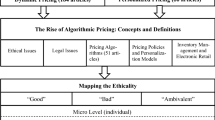Abstract
The authors construct an IPO selling mechanism with risk neutral retail investors, and two institutional investors that are better-informed and less-informed, respectively. In the mechanism, in addition to the main constraints such as the individual rationality (IR), the incentive compatibility (IC), and the feasibility constraint (FC), the authors consider two more typical constraints: There is a lower bound and no bound for allocation of the shares to two institutional investors. The authors derive the explicit expression of the optimal allocation of the shares to the investors. Under the lower bound constraint, the optimal mechanism will encourage the better-informed bidder to report sufficiently higher signal in order to get shares. If he gets allocation of shares, then the higher signal he reports, the more shares he will get, and the more the issuer’s expected maximum revenue will be.
Similar content being viewed by others
References
Benveniste L M and Spindt P A, How investment bankers determine the offer price and allocation of new shares, Journal of Financial Economics, 1989, 24(2): 343–361.
Ritter J R and Welch I, A review of IPO activity, pricing, and allocations, Journal of Finance, 2002, 57(4): 1795–1828.
Jenkinson T and Jones H, IPO pricing and allocation: A survey of the views of institutional investors, The Review of Financial Studies, 2009, 22(4): 1477–1504.
Biais B, Bossaerts P, and Rochet J C, An optimal IPO mechanism, Review of Economic Studies, 2002, 69(1): 117–146.
Chiang Y M and Sherman A E, Endogenous entry and partial adjustment in IPO auctions: Are institutional investors better informed? The Review of Financial Studies, 2010, 23(3): 1200–1230
Gong R and Yao D, Optimal IPO mechanism design: theory and practice in China, South China Journal of Economics, 2012, 30(12): 3–17.
Malakhov A, The role of uninformed investors in an optimal IPO mechanism, or what Google did right and Facebook did wrong. August 5, 2013. Available at SSRN: http://ssrn.com/abstract =687167.
Bennouri M and Falconieri S, The optimality of uniform pricing in IPOs: An optimal auction approach, Review of Finance, 2008, 12(4): 673–700.
Leite T, Bookbuilding with heterogeneous investors, Journal of Financial Intermediation, 2006, 15(2): 235–253.
Leite T, Adverse selection, public information, and underpricing in IPOs, Journal of Corporate Finance, 2007, 13(5): 813–828.
Povel P and Singh R, Using bidder asymmetry to increase seller revenue, Economics Letters, 2004, 84(1): 17–20.
Myerson R B, Optimal auction design, Mathematics of Operations Research, 1981, 6(1): 58–73.
Author information
Authors and Affiliations
Corresponding author
Additional information
This work was supported by the National Natural Science Foundation of China under Grant No. 71571044.
This paper was recommended for publication by Editor WANG Shouyang.
Rights and permissions
About this article
Cite this article
Lu, Y., Liu, S. Optimal IPO mechanism with retail investors and two asymmetric institutional investors. J Syst Sci Complex 30, 411–420 (2017). https://doi.org/10.1007/s11424-016-5016-5
Received:
Revised:
Published:
Issue Date:
DOI: https://doi.org/10.1007/s11424-016-5016-5




